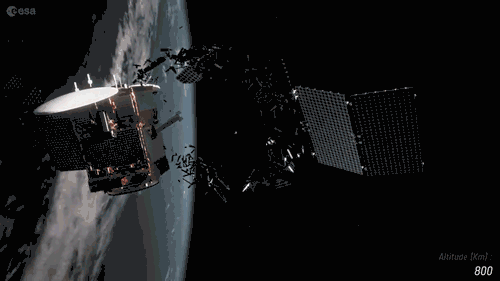Innovative Space Debris Removal: A Look at ClearSpace's Mission
Written on
Chapter 1: The Rise of Space Debris
In a remarkable step forward, a new initiative is underway to create a space debris removal system. ClearSpace, a Swiss startup, has been collaborating with the European Space Agency (ESA) since 2020 to develop a project akin to a vacuum cleaner for space junk.

[Photo: European Space Agency, CC BY-SA 3.0 IGO, via Wikimedia Commons]
Recently, this project successfully completed a significant technological review, paving the way for a mechanical device to intercept and eliminate a piece of a Vega rocket by 2026. So, what’s the current state of space debris?
According to a statistical model from the ESA, there are approximately:
- 36,500 objects larger than 10 cm,
- 1 million objects with a diameter between 1-10 cm,
- 130 million objects measuring 1 mm to 1 cm in size.
Collectively, these objects weigh around 10,700 tons. These statistics reflect the situation as of December 2022.
Section 1.1: Implications of Space Junk
The surge in space debris poses serious risks, potentially leading to the Kessler syndrome. This phenomenon occurs when debris in low Earth orbit collides, creating even more fragments. Initially theorized by NASA astrophysicist Donald J. Kessler, this scenario is increasingly becoming a pressing concern.
As the volume of debris accelerates, the risk of collision with operational satellites and rockets rises dramatically, necessitating innovative solutions for debris removal.
Subsection 1.1.1: The ClearSpace-1 Mission
The ClearSpace initiative, known as ClearSpace-1, aims to develop a satellite capable of capturing dangerous space debris. Upon reaching a targeted piece of junk, it will deploy four mechanical arms to secure the debris and guide it back to Earth, where both will disintegrate upon atmospheric re-entry.
However, this operation is far from straightforward. Each mission is fraught with technological hurdles, from designing the satellite to ensuring it can withstand the harsh conditions of space. Moreover, the system must operate with a high degree of reliability, especially as ClearSpace-1 embarks on its deorbiting mission.

Space debris — [Photo: ESA, CC BY-SA 3.0 IGO, via Wikimedia Commons]
Section 1.2: Capturing Space Junk
To successfully capture space debris, the satellite must be meticulously guided along a trajectory that minimizes the relative velocity between the debris and the satellite at the moment of capture. This requires precise navigation and control to avoid catastrophic failures.
A team of five engineers from the LMRS of CBK PAN has worked on designing the chaser-target system to facilitate this grappling maneuver. Extensive testing involved scaling the system four times to fit onto a specialized testing apparatus, known as a granite table, where the interception can be simulated in a controlled environment.
Chapter 2: Human Safety and Space Debris
As the space garbage truck moves closer to deployment, the hope is that more satellites equipped with grappling technology will soon join orbit. ESA’s Space Debris Environment report underscores the urgent need for cleanup operations to prevent an exponential rise in space junk.
Large debris not only endangers spacecraft but also poses a significant risk to human safety. Incidents involving uncontrolled re-entries of Chinese rockets have heightened concerns about debris falling unpredictably.
Current models for predicting atmospheric re-entry are continuously refined, as scientists often struggle to ascertain the rotation and orientation of various objects. Unlike simple shapes, most objects sent to space are irregular, complicating predictions of their flight paths.
The first video titled "Does Space Debris Ever Break Down Naturally?" explores the dynamics of space debris and its potential for natural degradation.
The second video, "This Satellite Net Is Cleaning Up Space Junk," highlights innovative methods being used to tackle the growing problem of orbital debris.
In conclusion, as we stand on the brink of a new era in space exploration and debris management, it's crucial to support initiatives like ClearSpace that aim to safeguard both our satellites and our planet.
How exciting it is that you've reached the end of this article! If you found this information valuable, I would greatly appreciate your support by giving some claps or following my work. A tip would also be wonderful! Thank you!